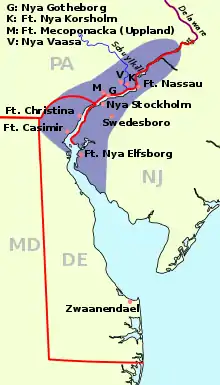Invasion of New Sweden
After the start of the Second Northern War, the Dutch seized New Sweden and soon absorbed it into New Netherlands.
| Invasion of New Sweden | |||||||
|---|---|---|---|---|---|---|---|
| Part of the Second Northern War | |||||||
 The map of New Sweden, 1638 | |||||||
| |||||||
| Belligerents | |||||||
|
|
| ||||||
| Commanders and leaders | |||||||
| Peter Stuyvesant |
Johan Risingh | ||||||
| Strength | |||||||
|
7 Ships 300 Soldiers [1] | Various Fortifications, and the soldiers present at the forts | ||||||
Background
New Sweden was a Swedish colony established along the Delaware River in 1638, under the leadership of Peter Minuit. The colony thrived for several years, attracting Swedish and Finnish settlers who engaged in fur trading with the Native Americans in the region. The Dutch, on the other hand, had established their own colony of New Netherland, centered on the island of Manhattan, and had ambitions to expand their territorial holdings.
Tensions between the Dutch and Swedes in North America escalated in the early 1650s. The Dutch West India Company, which governed New Netherland, saw New Sweden as a threat to its trade dominance and territorial ambitions in the region. The Dutch West India Company was particularly concerned about the lucrative fur trade conducted by the Swedish colonists with the Native American tribes, which had the potential to undermine the Dutch trade monopoly.[2] In 1654, Peter Stuyvesant,the Director-General of New Netherland, embarked on a diplomatic mission to New Sweden to assert Dutch authority and negotiate the surrender of the Swedish colony. However, the Swedish Governor Johan Risingh rejected Stuyvesant's demands and refused to submit to Dutch rule.[3]
Invasion
In response to the refusal, Stuyvesant returned to New Netherland, and the Dutch West India Company decided to use military force to secure control over New Sweden. In September 1655, Stuyvesant led a military expedition consisting of a fleet of seven ships and a force of over 300 soldiers, sailors, and colonists to invade New Sweden. They first captured their quarters, and made the majority of Swedes there prisoners, then sailed to the fort called Trinity, and capturing it without much resistance. They took the Swedish flag down, and hoisted the Dutch one up. They then sailed to Fort Christina, and besieged it for 14 days until the Swedes surrendered. Afterwards they plundered New Gothenburg, and captured the rest of the forts. [4]
Aftermath
Following the Dutch victory, the territory was reorganized and incorporated into New Netherland. The former New Sweden colony was divided into three districts: New Amstel (present-day New Castle), Hoornkill (present-day Lewes, Delaware), and Christina (present-day Wilmington).
References
- Francis, William (2013). Along the Christina River. Arcadia. p. 7. ISBN 9781467120432.
- Krissoff Boehm, Lisa; Corey, Steven H (2014). America's Urban History. Routledge. p. 60. ISBN 9781317813323.
- Pigs, Pork, and Heartland Hogs From Wild Boar to Baconfest. p. 46.
- The Register of Pennsylvania Volume 1. 1828. p. 4.